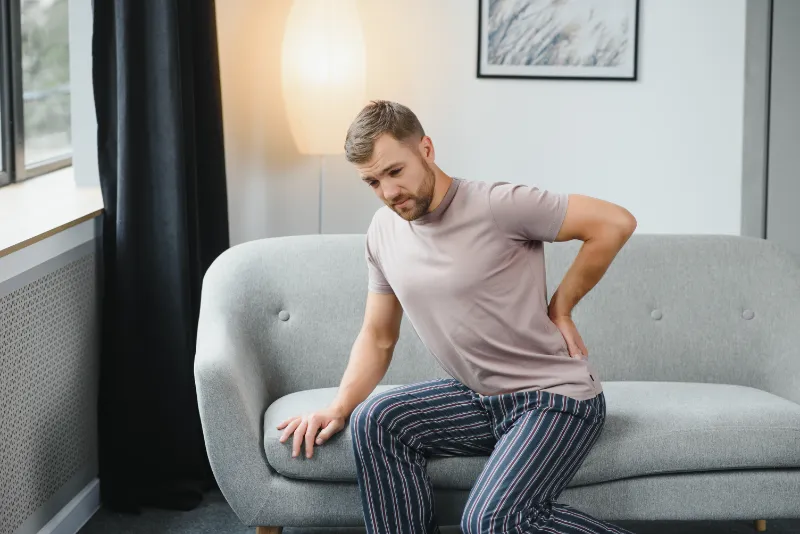Ankylosing Spondylitis

Ankylosing Spondylitis
Ankylosing Spondylitis (AS) is a chronic inflammatory condition that predominantly affects the spine, causing stiffness and pain. Over time, the pain typically progresses from the lower back to the upperback. Severe cases may result in the fusion of the spinal joints, leading to significant stiffness. Other areas, such as the hips, chest wall, and heels, can also be affected. In children, symptoms usually start in the hips, knees, heels, or big toes and later progress to the spine
Genetic Risk Factors
Genetic factors, including the presence of ERAP1, ERAP2, and interleukin-23R, are known to increase the risk of developing AS. Another critical factor is the presence of the HLA-B27 marker, although its presence does not guarantee the development of AS.
The Role of Microbiome
An exciting area of research has revealed a connection between the gut microbiome and AS. The gut microbiome, comprising trillions of microorganisms, has been linked to various health conditions, including AS and Crohn’s disease. Specifically, the bacterium Klebsiella has been shown to trigger AS and Crohn’s disease due to cross-reactivity in HLA-B27 genetically susceptible patients.
Associated Conditions
AS may also come with other conditions such as uveitis (inflammation of the eye) and vasculitis (inflammation of the blood vessels).
Assessment
A key part of managing AS is regular assessment. The Schoeber’s test is one method used to assess the restriction in lumbar flexion. While the patient is standing, the examiner marks two points on the back: 5 cm below and 10 cm above the level of the fifth lumbar vertebra. The patient is then asked to touch their toes while keeping their knees straight. If the distance between the two points does not increase by at least 5 cm (total distance greater than 20 cm), it indicates a restriction in lumbar flexion.
Managing Ankylosing Spondylitis
Managing AS will require a good multidisciplinary approach.
- Rheumatologist: I have good relationships with world-class rheumatologists who can evaluate whether you need TNF therapy.
- Functional Medicine: Similarly, if the gut microbiome requires significant attention beyond my nutritional therapy skills, functional medicine can more thoroughly assess gut function and tailor an approach.
I can provide:
- a. Education: Using my 5 pillars
- Understanding your pain, its causes, how you can modify it and understanding the rehabilitation process.
- Understanding ergonomics at work and home, and optimising rest and recovery.
- Understanding nutrition, hydration, and supplementation.
- Understanding the influence of psychology & stress management.
- Understanding technology accelerators, biohacking, and the environment.
- b. Hands-On Treatment: To improve range of motion and provide relief as needed.
- c. Home Exercise Programme: To normalise range of motion, improve strength and endurance as part of gradually returning to all your normal activities.
- a. Education: Using my 5 pillars
Case Study
ES came to see me with 3 months of pain in the left sacroiliac joint. She is HLA-B27 positive and was diagnosed with ankylosing spondylitis. ES’s rheumatologist decided she didn’t need to start anti-TNF. ES had clear signs of dysbiosis- too many “bad” bacteria in the gut and altered bowel movements. We started with education on the 5 pillars, and as part of this, ES followed a highly specialised diet to starve the Klebsiella bacteria and improve the gut microbiome. In addition, she did her home exercise program, and I provided some manual therapy for pain relief. After 5 weeks, her pain had subsided.
AS is a complicated chronic condition and I explained that it was highly likely her symptoms may return but by understanding the 5 Pillars as they relate to AS she has a good chance of controlling the controllable variables.
Conclusion
Ankylosing Spondylitis is a complex condition influenced by genetic, microbiome, and environmental factors. Managing it requires a multidisciplinary approach involving rheumatologists, functional medicine, and personalised treatment plans encompassing education, hands-on treatment, and a home exercise program. Regular assessment and monitoring are crucial for managing the condition effectively.
If you suspect you have AS, consult a healthcare professional for a comprehensive assessment and personalised management plan.
Success stories from our clients
EXCELLENT25 reviews on Lesley BeckerKieran is excellent. I cannot thank him enough for his help. Kieran’s professional skills and genuinely kind manner are rare.
Lesley BeckerKieran is excellent. I cannot thank him enough for his help. Kieran’s professional skills and genuinely kind manner are rare. N OKieran has recently provided treatment for my exercise-induced neck pain and migraines. I am a medical doctor. When I was a second-year medical student, I had a head injury that unfortunately led to persistent post-concussion symptoms. I suffered from intractable headaches, migraines, visual disturbances, sensory overload, neck pain, insomnia and exercise intolerance for years. After completing medical school and undergoing specialised post-graduate medical training, I found myself extensively relying on pain relief medications. However, over time, I began to realize that I run out of options. I further trained in functional and integrative medicine, nutrition and acupuncture in hopes of finding some relief. However, my post-concussion symptoms persisted despite all my efforts. Eventually, I came across hyperbaric oxygen therapy ( HBOT ) and had comprehensive training in HBOT. Having found no hyperbaric clinic with the medical standards I was looking for in London, I ended up founding NUMA, my own hyperbaric clinic. HBOT tremendously helped with my spontaneous chronic headaches and some other TBI-related symptoms, but, I still suffered from upper body exercise-induced migraines and intermittent neck pains. If I did not exercise, I was no longer having any migraines. But, I love exercising, and as a medical doctor, I know how important to exercise regularly. I tried physiotherapy to resolve my remaining symptoms which sadly did not help. Eventually, I accepted that I would not be able to do any strength training, and kept walking and doing other forms of exercise that did not involve my upper body. After seeing Kieran helping some of my patients with very complex neurological backgrounds, I decided to have a course of treatment for myself with him. Kieran assessed my condition thoroughly and created a personalised treatment plan for me. He gradually got me back to exercise that involves my upper body too, and completely transformed my threshold for exercise-induced neck pains and migraines. I am a still work in progress, but, I am continuously improving my exercise capacity. I no longer suffer from neck pain. I will continue to refer my patients to Kieran and have my top-up treatments with him. Thank you, Kieran. I could not be more grateful. Dr Nur Ozyilmaz Medical Director of NUMA, Hyperbaric Oxygen Clinic
N OKieran has recently provided treatment for my exercise-induced neck pain and migraines. I am a medical doctor. When I was a second-year medical student, I had a head injury that unfortunately led to persistent post-concussion symptoms. I suffered from intractable headaches, migraines, visual disturbances, sensory overload, neck pain, insomnia and exercise intolerance for years. After completing medical school and undergoing specialised post-graduate medical training, I found myself extensively relying on pain relief medications. However, over time, I began to realize that I run out of options. I further trained in functional and integrative medicine, nutrition and acupuncture in hopes of finding some relief. However, my post-concussion symptoms persisted despite all my efforts. Eventually, I came across hyperbaric oxygen therapy ( HBOT ) and had comprehensive training in HBOT. Having found no hyperbaric clinic with the medical standards I was looking for in London, I ended up founding NUMA, my own hyperbaric clinic. HBOT tremendously helped with my spontaneous chronic headaches and some other TBI-related symptoms, but, I still suffered from upper body exercise-induced migraines and intermittent neck pains. If I did not exercise, I was no longer having any migraines. But, I love exercising, and as a medical doctor, I know how important to exercise regularly. I tried physiotherapy to resolve my remaining symptoms which sadly did not help. Eventually, I accepted that I would not be able to do any strength training, and kept walking and doing other forms of exercise that did not involve my upper body. After seeing Kieran helping some of my patients with very complex neurological backgrounds, I decided to have a course of treatment for myself with him. Kieran assessed my condition thoroughly and created a personalised treatment plan for me. He gradually got me back to exercise that involves my upper body too, and completely transformed my threshold for exercise-induced neck pains and migraines. I am a still work in progress, but, I am continuously improving my exercise capacity. I no longer suffer from neck pain. I will continue to refer my patients to Kieran and have my top-up treatments with him. Thank you, Kieran. I could not be more grateful. Dr Nur Ozyilmaz Medical Director of NUMA, Hyperbaric Oxygen Clinic ViktorKieran helped me cure my back pain over the long run with only a couple of sessions. His help has allowed me to continue a variety of intensive physical activities pain-free. Top physio.
ViktorKieran helped me cure my back pain over the long run with only a couple of sessions. His help has allowed me to continue a variety of intensive physical activities pain-free. Top physio. Amelia WattsKieran is not only a highly knowledgeable & skilled physiotherapists but also extremely caring. I would highly recommend!
Amelia WattsKieran is not only a highly knowledgeable & skilled physiotherapists but also extremely caring. I would highly recommend! Agi BorekHighly recommended! I came to Kieran with my knee injury and the treatment he did was very helpful! He also recommended me a few simply exercises I can do at home to recover faster!
Agi BorekHighly recommended! I came to Kieran with my knee injury and the treatment he did was very helpful! He also recommended me a few simply exercises I can do at home to recover faster! Peter BodiKieran is a very experienced physiotherapist with a wealth of knowledge and practical solutions for the many different manifestation of pain in the lower back.
Peter BodiKieran is a very experienced physiotherapist with a wealth of knowledge and practical solutions for the many different manifestation of pain in the lower back. jay thakrarI couldn't be more grateful to Kieran for helping me resolve my back pain issues. His thorough and holistic approach was key in reducing my pain levels almost immediately and keeping me free of symptoms long term.
jay thakrarI couldn't be more grateful to Kieran for helping me resolve my back pain issues. His thorough and holistic approach was key in reducing my pain levels almost immediately and keeping me free of symptoms long term. Maria D'AgostinoI found kieran very competent and knowledgeable in his job. He is very keen on helping and flexible with hours.Load more
Maria D'AgostinoI found kieran very competent and knowledgeable in his job. He is very keen on helping and flexible with hours.Load more
